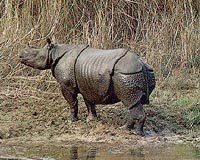| . |  |
. |
Sheffield, UK (SPX) Sep 24, 2010 Researchers at the University of Sheffield have discovered that cuckoo eggs are internally incubated by the female bird for up to 24 hours before birth, solving for the first time the mystery as to how a cuckoo chick is able to hatch in advance of a host's eggs and brutally evict them. Published in the journal Proceedings of the Royal Society of London, Series B, the research shows that internal incubation allows the cuckoo chick to hatch before its nest mates, evict them, and monopolise the food brought by the foster parents. Although previous studies have suggested early hatching is achieved partly through the cuckoo producing a small egg which develops faster, it has long been suspected that there might be another reason for this. A team from Sheffield, headed up by Professor Tim Birkhead, from the University's Department of Animal and Plant Sciences, worked with cuckoo researchers across Europe, to examine the newly laid eggs of eight cuckoos, and discovered that each one was at a more advanced stage than is normal among small birds. To test the idea that this advanced development was a result of the female cuckoo retaining the egg inside her, they simulated `internal incubation' in another species; the zebra finch. The researchers took recently laid finch eggs and incubated them for 24 hours at body temperature, which is 40oC in both the finch and the cuckoo. After this time, the zebra finch eggs were at the same stage as the cuckoo eggs at the time they were laid. Superficially this suggested that the internal incubation gives the cuckoo a 24 hour head start over its host's eggs, but the researchers discovered it is in fact more than this. When eggs are incubated by the adult birds in the nest, their eggs are at about 36oC. Inside the female, the egg is at a body temperature of 40oC. This difference in temperature means that 24 hours at 40oC gives the cuckoo egg a 31 hour head start over the host eggs. Most birds release their ovum or the yolk of the egg from the ovary 24 hours before it is laid. Fertilisation occurs within 15 minutes of ovulation, and the ovum then spends about 24 hours having the albumen, or egg white, and the shell put on to form a normal egg. This fully formed egg is laid 24 hours after ovulation. Significantly, about six hours after the ovum is fertilised, the microscopic embryo begins to develop and by the time the egg is laid, the embryo contains some 10,000 cells. It is only after two days of incubation that there are any signs, visible to the naked eye, that the egg is developing and an embryo forming. In the cuckoo however, the team demonstrated that the egg is ovulated and fertilised and then six hours later embryo development begins. As the egg passes down the oviduct, or egg tube, the white and shell are added, and once the egg is fully formed, about 24 hours after it was released from the ovary, it then sits in the female's oviduct for a further 24 hours. In other words, by the time the cuckoo egg is laid, it has had 18 to 24 hours of internal incubation at 40oC and hatches 31 hours ahead of any host egg laid at the same time. Professor Tim Birkhead, from the Department of Animal and Plant Sciences at the University of Sheffield, said: "The idea of internal incubation in birds has until now been considered impossible because it was assumed that female birds could not hold onto a fully formed egg. "In fact, the idea of internal incubation by cuckoos was suggested as early as 1800, but then ignored. Our results show that internal incubation gives cuckoo chicks that crucial head start in life, allowing them to dispose of their nest mates - a superb adaptation to being a brood parasite."
Share This Article With Planet Earth
Related Links The University of Sheffield Darwin Today At TerraDaily.com
 Elderly Malaysian rhino enlisted in breeding attempt
Elderly Malaysian rhino enlisted in breeding attemptKuala Lumpur (AFP) Sept 23, 2010 Malaysian wildlife officials on Borneo island said Thursday they will try to artificially inseminate an elderly female rhinoceros in a bid to revive one of the world's most endangered species. Gelegub, a Sumatran rhino who at 28-years-old is equivalent to a 70-something grandmother in human terms, will be impregnated with sperm from a virile young male rhino. "Gelegub is too old to mate ... read more |
|
| The content herein, unless otherwise known to be public domain, are Copyright 1995-2010 - SpaceDaily. AFP and UPI Wire Stories are copyright Agence France-Presse and United Press International. ESA Portal Reports are copyright European Space Agency. All NASA sourced material is public domain. Additional copyrights may apply in whole or part to other bona fide parties. Advertising does not imply endorsement,agreement or approval of any opinions, statements or information provided by SpaceDaily on any Web page published or hosted by SpaceDaily. Privacy Statement |